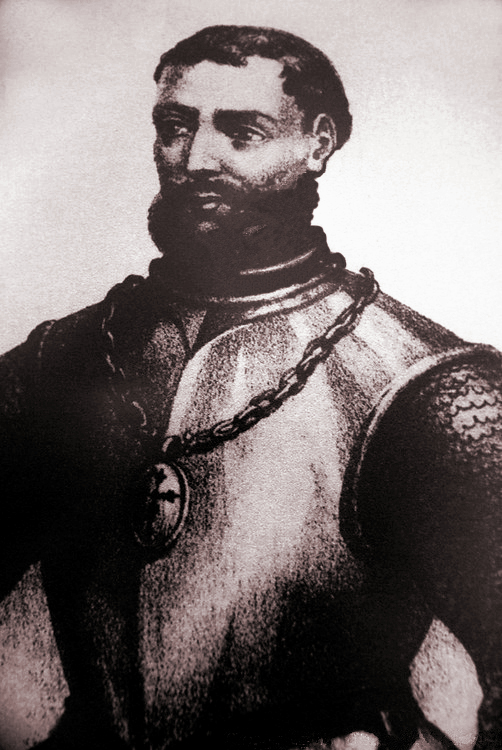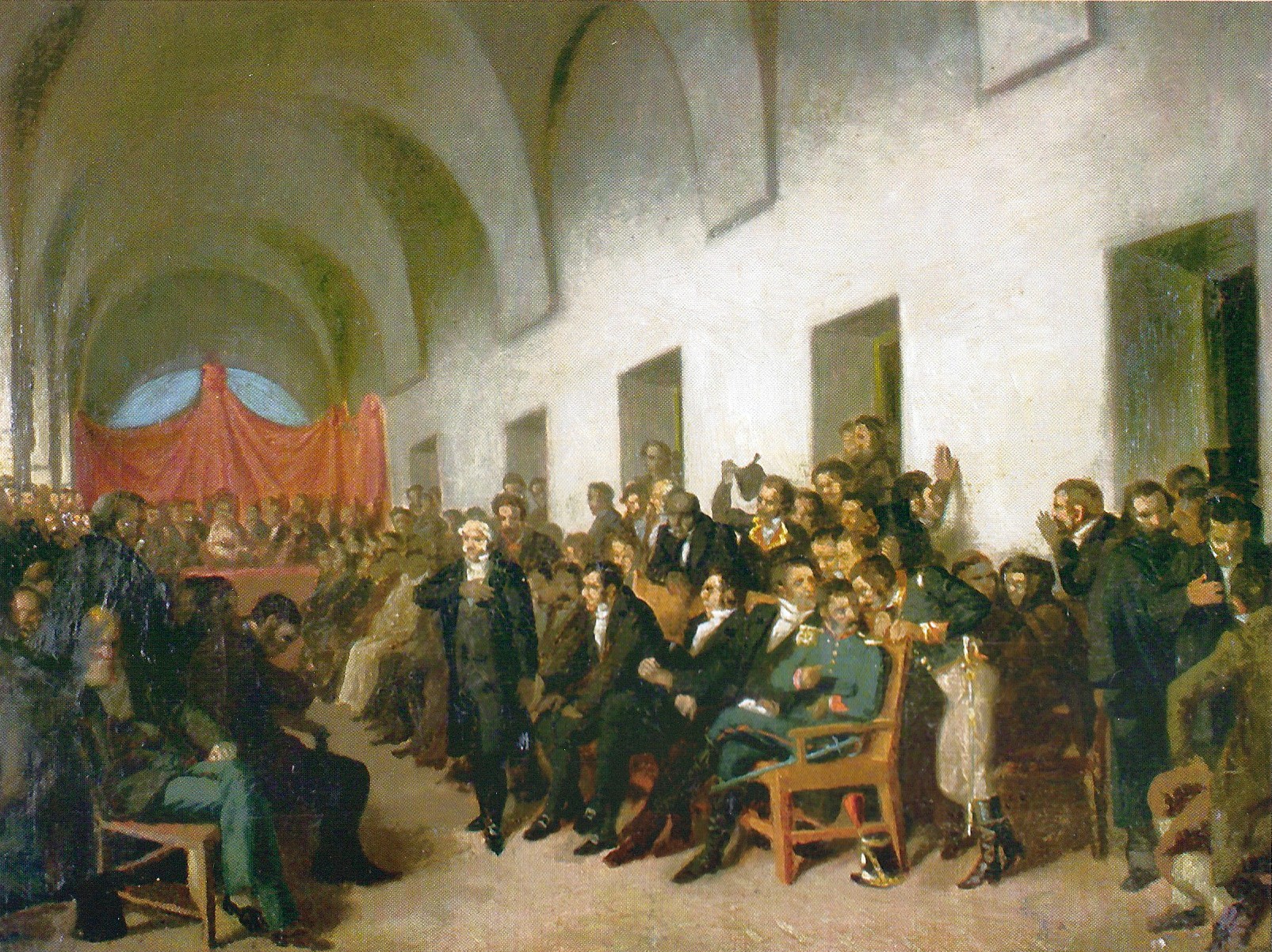|
Diego Velázquez De Cuéllar
Diego Velázquez de CuéllarPronounced: (1465 – c. June 12, 1524) was a Spanish conquistador and the first governor of Cuba. In 1511 he led the successful conquest and colonization of Cuba. As the first governor of the island, he established several municipalities that remain important to this day and positioned Cuba as a center of trade and a staging point for expeditions of conquest elsewhere. From Cuba he chartered important expeditions that led to the Spanish discovery and conquest of the Aztec Empire. Early life Little is known about the early life of Velázquez. He was born in Cuéllar around 1465, in the Segovia region of Spain. For a time he was a member of the Spanish military and served in Naples. Afterwards he returned to Spain and lived in Seville. In September 1493, Velázquez was one of 1500 men who sailed with Columbus on his second voyage to the New World. Velázquez never returned to Spain.Florstedt 1942 Velázquez settled on the island of Hispaniol ... [...More Info...] [...Related Items...] OR: [Wikipedia] [Google] [Baidu] |
Cuéllar
Cuéllar () is a municipality in the Province of Segovia, within the autonomous community of Castile and León, Spain. The municipality had a population of 9,730 inhabitants according to the municipal register of inhabitants (INE) as of 1 January 2010, divided into 4,929 men and 4,801 women. Cuéllar is located on a hill and is 60 km northeast of the capital city of Segovia and 50 km south of Valladolid. It occupies an area of , and it is above sea level. The Cerquilla and Cega rivers flow through the town. To the north, the town borders the municipality of Bahabón (the province of Valladolid); to the south, it borders Sanchonuño; to the east is Frumales, and to the west are San Cristóbal de Cuéllar and Vallelado. Inhabitants of Cuéllar traditionally grow different crops (such as cereals, vegetables, chicory, legumes, and beets) and raise livestock, including pigs, sheep, and cows. Forestry and resin production were once important economic resources. History Me ... [...More Info...] [...Related Items...] OR: [Wikipedia] [Google] [Baidu] |
Pedro De Alvarado
Pedro de Alvarado (; c. 1485 – 4 July 1541) was a Spanish conquistador and governor of Guatemala.Lovell, Lutz and Swezey 1984, p. 461. He participated in the conquest of Cuba, in Juan de Grijalva's exploration of the coasts of the Yucatán Peninsula and the Gulf of Mexico, and in the conquest of the Aztec Empire led by Hernán Cortés. He is considered the conquistador of much of Central America, including Guatemala, Honduras and El Salvador. Character and appearance Pedro de Alvarado was flamboyant and charismatic, and was both a brilliant military commander and a cruel, hardened man. His hair and beard were red, which reminded the Aztecs of their sun-god (often painted red) Tōnatiuh. He was handsome, and presented an affable appearance, but was volatile and quick to anger.Burland 1973, p. 216. He was ruthless in his dealings with the indigenous peoples he set out to conquer. Historians judge that his greed drove him to excessive cruelty,Recinos 1986, p. 205. and ... [...More Info...] [...Related Items...] OR: [Wikipedia] [Google] [Baidu] |
Diego Colón
Diego Columbus ( pt, Diogo Colombo; es, Diego Colón; it, Diego Colombo; 1479/1480 – February 23, 1526) was a navigator and explorer under the Kings of Castile and Aragón. He served as the 2nd Admiral of the Indies, 2nd Viceroy of the Indies and 4th Governor of the Indies as a vassal to the Kings of Castile and Aragón. He was the eldest son of Christopher Columbus and his wife Filipa Moniz Perestrelo. He was born in Portugal, either in Porto Santo in 1479/1480, or in Lisbon in 1474. He spent most of his adult life trying to regain the titles and privileges granted to his father for his explorations and then denied in 1500. He was greatly aided in this goal by his marriage to María de Toledo y Rojas, niece of the 2nd Duke of Alba, who was the cousin of King Ferdinand. Early life Diego was made a page at the Spanish court in 1492, the year his father embarked on his first voyage. Diego had a younger half-brother, Fernando, by Beatriz Enríquez de Arana. Diego ... [...More Info...] [...Related Items...] OR: [Wikipedia] [Google] [Baidu] |
Adelantado
''Adelantado'' (, , ; meaning "advanced") was a title held by Spanish nobles in service of their respective kings during the Middle Ages. It was later used as a military title held by some Spanish ''conquistadores'' of the 15th, 16th and 17th centuries. ''Adelantados'' were granted directly by the monarch the right to become governors and justices of a specific region, which they were charged with conquering, in exchange for funding and organizing the initial explorations, settlements and pacification of the target area on behalf of the Crown of Castile. These areas were usually outside the jurisdiction of an existing '' audiencia'' or viceroy, and ''adelantados'' were authorized to communicate directly with the Council of the Indies. The ''reconquista'' The term has its origins in the ''reconquista'' and comes from the phrase ''por adelantado'' ( Spanish: "in advance", although translations stating "one who goes before" and "the forward man" are also found). According to the ... [...More Info...] [...Related Items...] OR: [Wikipedia] [Google] [Baidu] |
Mayans
The Maya peoples () are an ethnolinguistic group of indigenous peoples of Mesoamerica. The ancient Maya civilization was formed by members of this group, and today's Maya are generally descended from people who lived within that historical region. Today they inhabit southern Mexico, Guatemala, Belize, El Salvador, and Honduras. "Maya" is a modern collective term for the peoples of the region, however, the term was not historically used by the indigenous populations themselves. There was no common sense of identity or political unity among the distinct populations, societies and ethnic groups because they each had their own particular traditions, cultures and historical identity. It is estimated that seven million Maya were living in this area at the start of the 21st century. Guatemala, southern Mexico and the Yucatán Peninsula, Belize, El Salvador, and western Honduras have managed to maintain numerous remnants of their ancient cultural heritage. Some are quite integrated int ... [...More Info...] [...Related Items...] OR: [Wikipedia] [Google] [Baidu] |
Yucatán Peninsula
The Yucatán Peninsula (, also , ; es, Península de Yucatán ) is a large peninsula in southeastern Mexico and adjacent portions of Belize and Guatemala. The peninsula extends towards the northeast, separating the Gulf of Mexico to the north and west of the peninsula from the Caribbean Sea to the east. The Yucatán Channel, between the northeastern corner of the peninsula and Cuba, connects the two bodies of water. The peninsula is approximately in area. It has low relief, and is almost entirely composed of porous limestone. The peninsula lies east of the Isthmus of Tehuantepec, the narrowest point in Mexico separating the Atlantic Ocean, including the Gulf of Mexico and Caribbean Sea, from the Pacific Ocean. Some consider the isthmus to be the geographic boundary between Central America and the rest of North America, placing the peninsula in Central America. Politically all of Mexico, including the Yucatán, is generally considered part of North America, while Guatemala an ... [...More Info...] [...Related Items...] OR: [Wikipedia] [Google] [Baidu] |
Francisco Hernández De Córdoba (Yucatán Conquistador)
Francisco Hernández de Córdoba (; in Córdoba – 1517 in Sancti Spíritus) was a Spanish ''conquistador'', known to history mainly for the ill-fated expedition he led in 1517, in the course of which the first European accounts of the Yucatán Peninsula were compiled. 1517 Expedition Together with some 110 discontented Spanish settlers in early colonial Cuba, Hernández de Córdoba petitioned the governor, Diego Velázquez de Cuéllar, for permission to launch an expedition in search of new lands and exploitable resources. This permission was granted after some haggling over terms, and the expedition consisting of three ships under Hernández de Córdoba's command left the harbor of Santiago de Cuba on February 8, 1517, to explore the shores of southern Mexico. The main pilot was Antón de Alaminos,Diaz, B., 1963, The Conquest of New Spain, London: Penguin Books, the premiere navigator of the region who had accompanied Christopher Columbus on his initial voyages; The pilot ... [...More Info...] [...Related Items...] OR: [Wikipedia] [Google] [Baidu] |
Local Government
Local government is a generic term for the lowest tiers of public administration within a particular sovereign state. This particular usage of the word government refers specifically to a level of administration that is both geographically-localised and has limited powers. While in some countries, "government" is normally reserved purely for a national administration (government) (which may be known as a central government or federal government), the term local government is always used specifically in contrast to national government – as well as, in many cases, the activities of sub-national, first-level administrative divisions (which are generally known by names such as cantons, provinces, states, oblasts, or regions). Local governments generally act only within powers specifically delegated to them by law and/or directives of a higher level of government. In federal states, local government generally comprises a third or fourth tier of government, whereas in unitary ... [...More Info...] [...Related Items...] OR: [Wikipedia] [Google] [Baidu] |
Cabildo (council)
A cabildo () or ayuntamiento () was a Spanish colonial, and early post-colonial, administrative council which governed a municipality. Cabildos were sometimes appointed, sometimes elected; but they were considered to be representative of all land-owning heads of household (''vecinos''). The colonial cabildo was essentially the same as the one developed in medieval Castile. The cabildo was the legal representative of the municipality—and its ''vecinos''—before the Crown, therefore it was among the first institutions established by the conquistadors themselves after, or even before, taking over an area. For example, Hernán Cortés established La Villa Rica de la Vera Cruz to free himself from the authority of the Governor of Cuba. The word ''cabildo'' has the same Latin root (''capitulum'') as the English word chapter, and in fact, is also the Spanish word for a cathedral chapter. Historically the term ''ayuntamiento'' was often preceded by the word ''excelentísimo ... [...More Info...] [...Related Items...] OR: [Wikipedia] [Google] [Baidu] |
Juan De Grijalva
Juan de Grijalva (; born c. 1490 in Cuéllar, Crown of Castile – 21 January 1527 in Honduras) was a Spanish conquistador, and a relative of Diego Velázquez.Diaz, B., 1963, The Conquest of New Spain, London: Penguin Books, He went to Hispaniola in 1508 and to Cuba in 1511. He was one of the early explorers of the Mexican coastline. 1518 expedition In 1518, Grijalva became one of the first to explore the shores of Mexico. According to Hernán Cortés, 170 people went with him, but according to Pedro Mártir, there were 300 people. The main pilot was Antón de Alaminos, the other pilots were Juan Álvarez (also known as ''el Manquillo''), Pedro Camacho de Triana, and Grijalva. Other members included Francisco de Montejo, Pedro de Alvarado, Juan Díaz, Francisco Peñalosa, Alonso de Ávila, Alonso Hernández, Julianillo, Melchorejo, and Antonio Villafaña. They embarked from the port of Matanzas, Cuba, with four ships in April 1518. After rounding the Guaniguanico ... [...More Info...] [...Related Items...] OR: [Wikipedia] [Google] [Baidu] |
Havana
Havana (; Spanish: ''La Habana'' ) is the capital and largest city of Cuba. The heart of the La Habana Province, Havana is the country's main port and commercial center.Cuba '' The World Factbook''. . The city has a population of 2.3million inhabitants, and it spans a total of – making it the largest city by area, the most populous city, and the [...More Info...] [...Related Items...] OR: [Wikipedia] [Google] [Baidu] |







